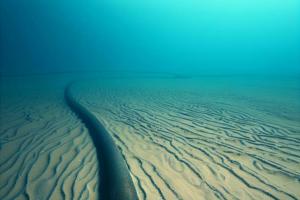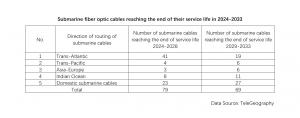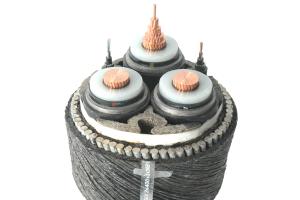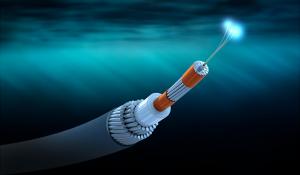The demand for interconnection bandwidth has witnessed a sharp increase, propelling global submarine cables into a phase of old and new replacement.
LOS ANGELES, CALIFORNIA, UNITED STATES, July 25, 2023/EINPresswire.com/ — In the midst of a rapidly evolving digital landscape, the global submarine cable industry is undergoing a profound transformation driven by the inevitable generational change. Aging submarine cables will be retired and a boom in the construction of cutting-edge submarine cable systems is under way. According to TeleGeography data, by the end of 2022, the number of submarine cables in production globally reached 469, with a total length of more than 1.39 million kilometers. And according to the announced plan, from 2023-2026, another 80 submarine cables will be put into production, with a total length of about 390,000 kilometers.
This wave of innovation and expansion will surely revolutionize global connectivity, facilitating seamless data exchange and ushering in a new era of enhanced economic and human exchange across continents and regions.
Submarine Cable Generation Change Drives Construction Boom
The design service life of submarine fiber optic cables is generally 25 years, creating an impetus for new and old replacements.
Replacing Outdated Cables
The world has built 464 submarine fiber optic cables, with 82 cables constructed before 1998 reaching their design service life. With the passage of time, submarine cables built in 1999-2003 and 2004-2008 amount to 79 and 69 respectively. A total of 148 submarine cables are projected to be retired in the next 10 years, creating a crucial time window for the layout of new submarine cables.
Expansion on the Horizon
Predictions by the China Academy of Information and Communications Technology indicate the construction of 153 new submarine cable systems, stretching approximately 770,000 kilometers, from 2023 to 2028. This ambitious expansion aims to meet the growing demand for international bandwidth and facilitate global data center layout.
Information Traffic Fuels Global Submarine Cable Expansion
The ever-increasing flow of Internet information traffic and the strategic distribution of data centers are spearheading transformative changes in the global submarine cable landscape. As the demand for interconnectivity surges, submarine cable networks within each region are witnessing continuous expansion.
Notably, traditional high-bandwidth routes like Europe-North America, Asia-North America, Latin America-North America, and Asia-Europe are experiencing strengthened construction efforts. Simultaneously, the introduction of novel submarine cable routes is gradually perfecting the architecture of oceanic networks, elevating global connectivity to unprecedented levels.
The capacity of submarine cables in key global directions is on a steep incline, reflecting the growing need for upgrading and constructing new systems. According to data from TeleGeography, global international bandwidth usage reached an impressive 3,811Tbps in 2022, with a remarkable compound annual growth rate (CAGR) of 44% from 2015 to 2022.
In terms of international bandwidth usage, the top-performing directions, in descending order, are intra-Europe, Europe-North America, intra-Asia, Asia-North America, and Latin America-North America. Additionally, the highest CAGR is observed in the following directions, listed in descending order: Asia-Oceania (57%), intra-Africa (56%), intra-Asia (53%), Africa-Middle East (51%), Asia-Europe (50%), and Africa-Europe (50%). These figures reflect the rapid expansion and evolution of submarine cable networks in regions with burgeoning Internet usage and data demand.
With the surge in international bandwidth usage and the exponential growth of data traffic, the need for high-speed and robust submarine cable systems has never been more critical. As the digital age continues to shape our global landscape, the development and upgrading of submarine cables are set to play a pivotal role in fostering seamless and efficient communication between continents and regions.
Strengthening Intra-Regional Connectivity Drives Submarine Cable Growth
The rise of regional economic integration has fueled the demand for internal connectivity within each region. From 2018 to 2022, a staggering 106 submarine cables were delivered globally, with a significant focus on enhancing connectivity within regions rather than between them.
Asia: A Network of Enhanced Connectivity
Asia has emerged as a hotspot for submarine cable development. With 29 new submarine cables and 17 under construction/proposed cables, the level of interconnectivity between Asian countries has surged significantly. Notable projects include the ADC and SJC2 submarine cables connecting China, Japan, and Singapore, as well as the IAX and MIST submarine cables connecting India and Singapore. In addition, domestic submarine cables within Indonesia and the Philippines, along with those between Southeast Asian countries, further strengthen intra-regional connectivity.
Europe: Building Bridges Across the Continent
Europe has also witnessed substantial progress in inter-country connectivity through submarine cables. There are 23 new and 14 under construction/proposed submarine cables within Europe, fostering robust data exchange between countries. These projects include submarine cables connecting island countries such as the UK and Iceland with continental European countries, submarine cables between European countries, and shorter submarine cables within the UK and Spain. Notable examples include the NO-UK submarine cable connecting the UK and Norway, the CrossChannelFibre submarine cable connecting the UK and France, and the Lonian submarine cable connecting Greece and Italy.
Africa: Rapid Upgrades to Intra-Sub-Regional Connectivity
Inter-country and inter-sub-regional connectivity in Africa has been rapidly upgraded, with six new intra-African and six under-construction/proposed submarine cables to further enhance intra-sub-regional connectivity in East Africa, West Africa, and Southeast Africa. Notable projects include the METISS submarine cable connecting South Africa and the Indian Ocean island countries, and the MarocTelecomWestAfrica submarine cable connecting multiple countries in West Africa.
Countries or Regions Bordering the Sea: Strengthening Oceanic Connections
Countries or regions bordering the oceans continue to strengthen their submarine cable connections. Oceania, Latin America, and North America have actively engaged in enhancing their connectivity with a total of 10, 8, and 7 new submarine cables, respectively. Additionally, 6, 5, and 6 submarine cables are under construction/proposed within Oceania, Latin America, and North America. Projects encompass both domestic submarine cables within some countries and inter-country submarine cables within the region. Noteworthy examples include the EAUFON submarine cable in the eastern Canadian Arctic, the SPSC/Mistral submarine cable connecting four countries in Latin America, and the CoralSea Cable System (CS) submarine cable connecting Australia, Papua New Guinea, and the Solomon Islands.
Interregional Capacity Expansion Powers Global Connectivity
Europe – North America, Asia – North America, Latin America – North America, Asia – Europe and other traditional directions of the construction of submarine cables continue to carry out steadily. The construction of submarine cables in the direction of Oceania-Asia and Oceania-North America is active. The capacity of newly built submarine cables is generally larger, supporting the high-speed growth of inter-regional bandwidth.
Europe-North America: Enhancing Transatlantic Communication
Five new and three under-construction/proposed submarine cables are being built to bolster connectivity between Europe and North America. These projects, such as the Dunant cable by Google and the Amitie cables by Meta and Microsoft, boast capacities of 250Tbps and 360Tbps respectively, facilitating seamless communication across the Atlantic.
Asia-North America: Strengthening Transpacific Links
In the Asia-North America direction, three new and seven under-construction/proposed submarine cables are set to improve connectivity between Asia and North America. Projects include the PLCN cable by Google and Meta, as well as the JUNO cable by SerenJuno with capacities reaching 144Tbps and 350Tbps respectively, further bridging the Pacific.
Latin America-North America: Uniting the Americas
The Latin America-North America direction is adding 5 new and 7 under-construction/proposed submarine cables, including Curie and GoldData-1, to enhance connectivity between the two continents.
Asia-Europe: Strengthening Eurasian Bonds
Asia-Europe is set to add 1 new and 4 under-construction/proposed submarine cables. Projects include the PEACE submarine cable connecting Pakistan, East Africa, and Europe, the SMW6 submarine cable connecting Singapore and France, and the IEX submarine cable connecting India and Italy, reinforcing the connectivity between Asia and Europe.
Asia-Oceania: Enhancing Intercontinental Links
Three new and one under-construction/proposed submarine cables, including the DJSC and INDIGO-West cables, are expected to strengthen connectivity between Asia and Oceania.
Oceania-North America: Boosting Transpacific Data Transfer
America is adding 2 new submarine cables, SouthernCrossNEXT and Hawaiki, to link Australia and the United States, facilitating seamless intercontinental data exchange.
The Future of Submarine Cables: Paving the Way to a Connected World
With each new cable laid, a web of enhanced connectivity is woven, creating bonds between nations and peoples. The digital age continues to shape our global landscape, and the growth of submarine cables plays a pivotal role in fostering seamless and efficient communication, powering economies, and advancing societies. The future of submarine cables is one of boundless potential, fostering an era of unparalleled global connectivity and innovation.
ZMS Cable
ZMS Cable
+ +86 37167829333
info@zmscable.es
Visit us on social media:
Facebook
Twitter
LinkedIn
YouTube
![]()

























